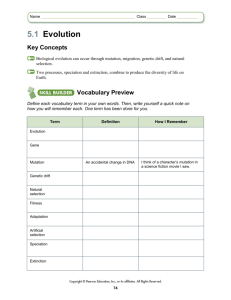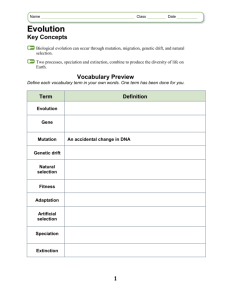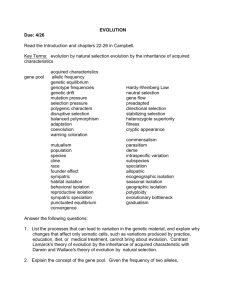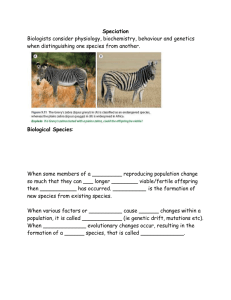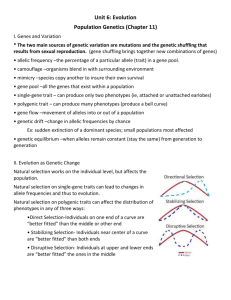Key exam I-b
advertisement
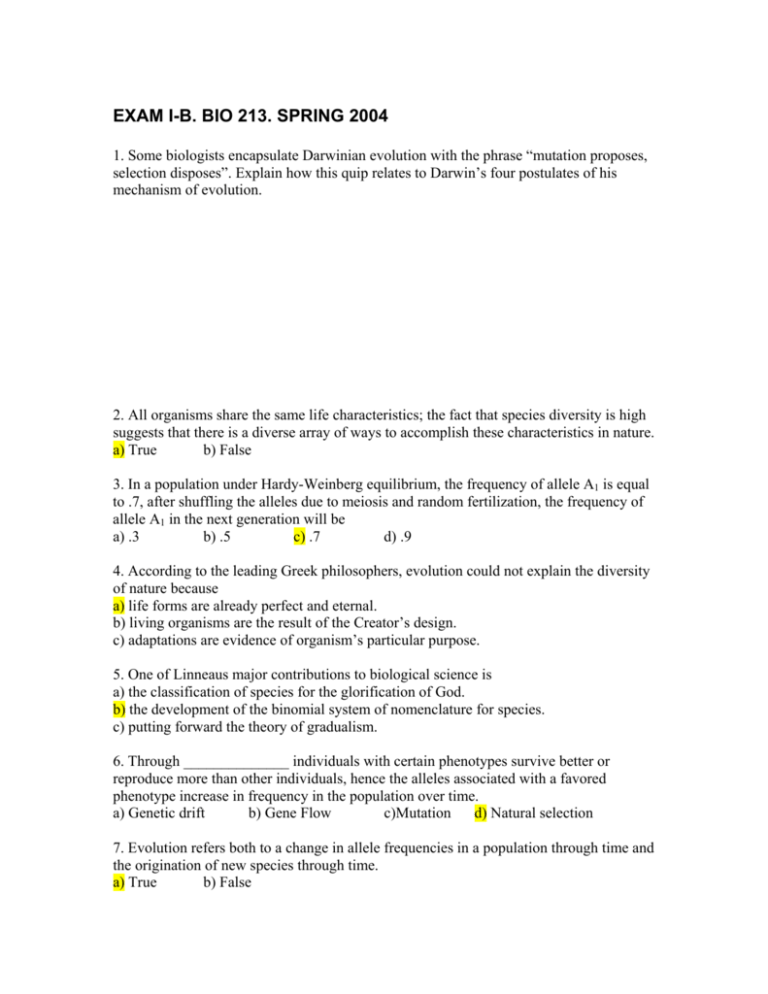
EXAM I-B. BIO 213. SPRING 2004 1. Some biologists encapsulate Darwinian evolution with the phrase “mutation proposes, selection disposes”. Explain how this quip relates to Darwin’s four postulates of his mechanism of evolution. 2. All organisms share the same life characteristics; the fact that species diversity is high suggests that there is a diverse array of ways to accomplish these characteristics in nature. a) True b) False 3. In a population under Hardy-Weinberg equilibrium, the frequency of allele A1 is equal to .7, after shuffling the alleles due to meiosis and random fertilization, the frequency of allele A1 in the next generation will be a) .3 b) .5 c) .7 d) .9 4. According to the leading Greek philosophers, evolution could not explain the diversity of nature because a) life forms are already perfect and eternal. b) living organisms are the result of the Creator’s design. c) adaptations are evidence of organism’s particular purpose. 5. One of Linneaus major contributions to biological science is a) the classification of species for the glorification of God. b) the development of the binomial system of nomenclature for species. c) putting forward the theory of gradualism. 6. Through ______________ individuals with certain phenotypes survive better or reproduce more than other individuals, hence the alleles associated with a favored phenotype increase in frequency in the population over time. a) Genetic drift b) Gene Flow c)Mutation d) Natural selection 7. Evolution refers both to a change in allele frequencies in a population through time and the origination of new species through time. a) True b) False 8. Which of the following is not one of Darwin’s pieces of evidence that evolution occurs? a) Progressive changes in characteristics of plants and animals can be seen in the fossil record b) Structural homologies are common across species c) The earth was created in 4004 B.C. d) The plants and animals of each continent are distinctive 9. List five fundamental characteristics of life. 10. _____________ is a measure of an individual’s ability to survive and reproduce. a) Linkage disequilibrium b) Adaptation c) Fitness d) Heredity 11. _____________ does not lead to a change in allele frequencies in a population. a) Mutation b) Gene flow c) Natural selection d) Inbreeding 12. A population under Hardy-Weinberg equilibrium is experiencing a) no mutation, random mating, natural selection, no gene flow, and no genetic drift. b) no mutation, random mating, no natural selection, no gene flow, and no genetic drift. c) no mutation, no random mating, no natural selection, no gene flow, and genetic drift. 13. A___________ is a group of individuals of one species living in the same geographic area. a) species b) population c) community d) sub-species 14. Darwin was greatly influenced by an essay written by ______________, which pointed out that human population increases more rapidly than its resources. a) James Hutton b) Jean-Baptiste Lamarck c) Thomas Malthus d) Charles Lyell 15. Darwin believed that the major driving force in evolution was a) natural selection. b) inheritance of acquired characteristics. c) uniformitarianism. d) scientific creation. 16. The indiscriminate use of antibiotic drugs in human populations is leading to an increase in the frequency of drug-resistant strains of certain bacteria. This type of natural selection is known as a) directional selection. b) stabilizing selection c) disruptive selection 17. The smallest unit of evolution is the: a) individual b) population c) species d) genus 18. A population under __________________ is a non-evolving population. a) frequency-dependent selection b) the founder effect c) Hardy-Weinberg equilibrium 19. All of these processes are likely to increase genetic variation in a population except a) mutation b) disruptive selection c) genetic drift d) gene flow 20. Briefly define and illustrate stabilizing selection. 21. On its own, _____________ is not considered an important mechanism of evolutionary change because it does not occur often enough at a specific locus. a) natural selection b) mutation c) gene flow d) inbreeding 22. In _______________ the outcome of natural selection is no change in the average value of a trait through time. a) directional selection b) stabilizing selection c) disruptive selection 23. Through ______________ individuals with phenotypes more attractive to mates tend to reproduce more than other individuals, hence the alleles associated with the favored phenotype increase in frequency in the population over time. a) natural selection b) sexual selection c) directional selection 24. _________ refers to the movement of alleles between populations. a) Gene flow b) Genetic drift c) Mutation d) Sexual selection 25. Lamarck’s theory of evolution was rejected by the scientists of his time because a) he could not provide evidence for its mechanism. b) Cuvier’s strong opposition to it. c) evidence of catastrophism rejected his theory. 26. Darwin’s journey on the Beagle and his reading of Lyell’s Principles of Geology contributed to the posterior development of his theory of evolution during a short bout of malaria. a) True b) False 27. This process generates genetic variation in a population by producing new alleles. a) Sexual recombination b) Mutation c) Gene flow d) sexual selection 28. In industrialized nations, the average height of the human population has been steadily increasing over 100 years. This increase has been explained as the result of better nutrition and less disease. Has the average height in these populations evolved? a) Yes b) No 29. A small number of marine isopods (Idotea montereyensis) distributed along the California coast, disperse to the rocky intertidal area (coastal habitat where the isopods are adapted to live) of the Anacapa Island to form a new population. Assuming there is no more migration from the original population, what is the most likely mechanism of evolution in the new island population in the next few generations? a) Gene Flow b) Genetic drift c) Mutation d) Inbreeding 30. Genetic variation in populations is crucial for evolution to occur. a) True b) False 31. Applying your knowledge on sympatric speciation and the discussion of the soapberry bug example seen in class, why is sympatric speciation more likely to occur in insect species? 32. A paleontologist uses the shape of morphological characteristics found in fossils to distinguish different species, which species concept is he applying to separate species? a) the biological b) the morphospecies c) the phylogenetic 33. A species is defined as evolutionary independent populations. Scientists agree on this definition but differ on the set of criteria used to identify them in nature. a) True b) False 34. What distinguishes a phylogenetic species? a) It has distinctive characteristics such as size, shape, or coloration. b) It represents a different twig in a phylogeny of populations. c) It is reproductively isolated from other species. 35. How does a species become evolutionary independent? a) Only through isolation. b) Only through divergence. c) Only when populations hybridize. d) Both through isolation of populations and divergence caused by genetic drift, natural selection and mutation. 36. These are mechanisms that keep two or more species reproductively isolated after they come back in contact with each other following isolation and divergence. a) Secondary contact only by prezygotic mechanisms. b) Secondary contact only by postzygotic mechanisms. c) Secondary contact by both prezygotic and postzygotic mechanisms. 37. What does it mean to say that populations are sympatric? a) They are related as ancestors and descendants. b) They share a common ancestor. c) They occupy the same geographic area. d) They occupy different geographic areas. 38. _________________ is a type of natural selection in which both extremes in a population are favored and the average phenotype is selected against. a) Directional selection b) Stabilizing selection c) Disruptive selection 39. _________________ is a type of nonrandom mating that produces changes in alleles frequencies of a population through time. a) Inbreeding b) Sexual selection c) Self-fertilization d) Sexual dimorphism 40. In Northern Cardinals (Cardinalis cardinalis), the male has brightly red plumage whereas the female’s plumage is drab red. The difference in the plumage coloration between the sexes is an example of a) sexual dimorphism b) sexual selection c) disruptive selection 41. What does it mean to say that populations are allopatric? a) They are related as ancestors and descendants. b) They share a common ancestor. c) They occupy the same geographic area. d) They occupy different geographic areas. 42. In this type of prezygotic mechanism, populations are isolated because they breed at different times. a) Temporal b) Gametic c) Behavioral d) Habitat 43. According to the Refugium hypothesis, during glaciation climate became cooler and drier in the Amazon region. Wet forests shrank to isolated islands surrounded by dry forests or savannah. Speciation occurs as populations diverge in isolated habitat refuges. Which type of speciation has occurred? a) Allopatric speciation through dispersal and colonization. b) Sympatric speciation through dispersal and colonization. c) Allopatric speciation through vicariance. 44. A small number of marine isopods (Idotea montereyensis) distributed along the California coast, disperse to the rocky intertidal area (coastal habitat where the isopods are adapted to live) of the Anacapa Island to form a new colony of isopods. Speciation occurs, assuming there is no more migration from the original population and there is divergence in both populations. Which type of speciation has occurred? a) Allopatric speciation through dispersal and colonization. b) Sympatric speciation through dispersal and colonization. c) Allopatric speciation through vicariance.
